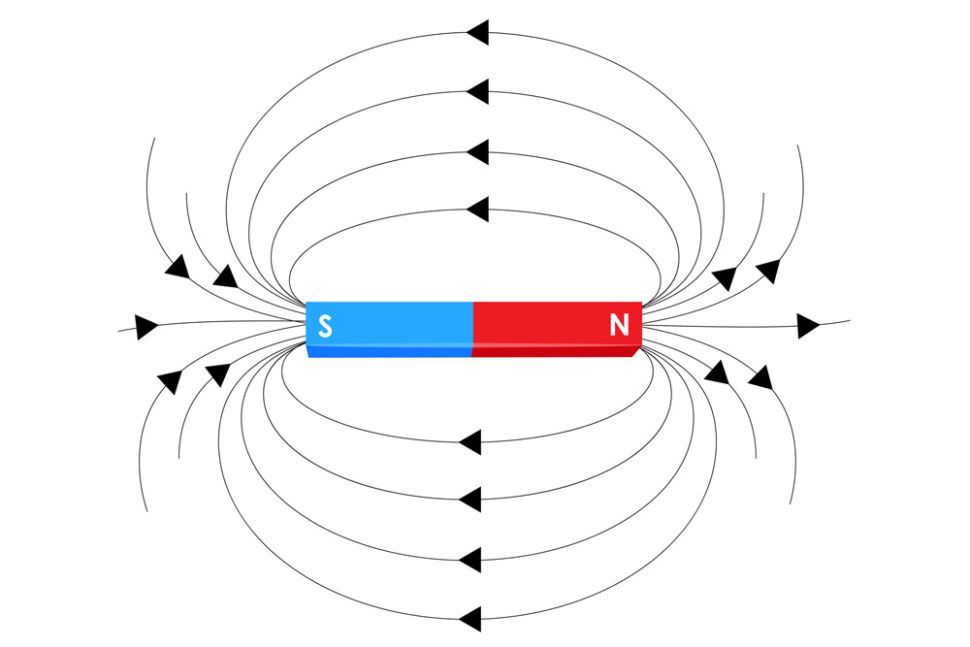Study Guide: Magnetism
Magnets
In order to understand Faraday’s Law of Induction, it is important to have a basic understanding of magnetic fields. Compared to the electric field, the magnetic field is more complex.
Magnetic Poles
While positive and negative electric charges can exist separately, magnetic poles always come in pairs—one north and one south. Typically, magnets of all sizes—from sub-atomic particles to industrial-size magnets to planets and stars—are dipoles (each has two poles).
Magnetic Fields
A magnetic field is often illustrated as lines of magnetic flux (force). In the case of a bar magnet, the flux lines exit from the north pole and curve around to reenter at the south pole. In this model, the number of flux lines passing through a given surface in space represents the flux density, or the strength of the field. However, this is only a model. A magnetic field is smooth and continuous and does not actually made of lines.
Magnetic Induction
If we run an electric current through a wire, it will produce a magnetic field around the wire. The direction of this magnetic field can be determined by the right-hand rule. If you extend your thumb and curl the fingers of your right hand, your thumb points in the positive direction of the current, and your fingers curl in the north direction of the magnetic field.
Demo 1: A Magnetic Field can Create Electricity
- Construct two wire loops, connect the ends of one to a battery with a switch, and connect the ends of the other loop to a galvanometer.
- Place the two loops close to each other in a face-to-face orientation, and turn on power to the first loop.
- The galvanometer connected to the second loop will indicate an induced current and then quickly return to zero.
Conclusion: A magnetic field created by the electric energy in a circuit can induce an electric current in a nearby circuit.
Demo 2: Induction Stove
- Place a piece of paper on an induction stove top and turn it on. The stove will not function and the paper will not get hot.
- Add some water to a pot made of magnetic material and place it on the stove. If possible, place some small heat-proof wafers between the paper and the pot.
- Turn the stove to a high setting. The water will soon boil, but the paper will not get hot.
- Make popcorn. Add only enough corn to lightly cover the bottom of the pan.
- Turn the stove to a high setting and be ready. It goes fast!
Conclusion: A strong electric current is used to create a strong magnetic force. Induction cooking uses electric currents to directly heat pots and pans through magnetic induction. Instead of using thermal conduction (gas or electric heat), induction almost instantly heats the cookware itself.
An electric current is passed through a coiled copper wire underneath the cooking surface, which creates a magnetic current in the cookware. This causes molecules in the metal pot to vibrate, and the molecular motion creates heat.
For induction to work, cookware must be made of a magnetic metal, such as cast iron or certain kinds of stainless steel. There is an easy way to check if cookware will work with an induction stove. If a magnet sticks to the bottom of the cookware, it can be used on an induction stove.
North is South!
We call these poles north and south after the direction in which compass needles point. However, since opposite poles attract, and like poles repel, the magnetic north pole of the Earth is actually a south magnetic pole because it attracts the north poles of compass needles!
Conclusion
- The electric current in the first loop produces a magnetic field, which in turn induces a current in the second loop, but only for an instant as the magnetic field is changing.
- When we turn off the switch, the meter deflects momentarily in the opposite direction. This indicates that it was a change in the intensity of the magnetic field, and not its strength or motion that induced the current.
- A magnetic field causes electrons in a conductor to move. This motion is called electric current. Eventually, the electrons reach a point where they are in equilibrium with the magnetic field, at which point they stop moving.
- When the electric field is removed or turned off, the electrons flow back to their original location, producing a current in the opposite direction.



